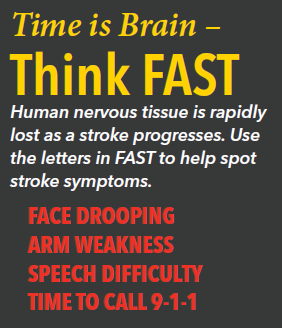STROKE: Two Patients Tell Their Stories
Stroke Treatment & Recovery
Jim Macaulay knew he was having a stroke. One evening about seven years ago, his right arm suddenly felt numb and he realized his right leg wasn’t responding. “When I tried to curse,” he said, “I found out my speech was slurred.”
Jim was rushed to MedStar St. Mary’s Hospital where test results showed he was having a hemorrhagic stroke. Within a short period of time, he was sent by helicopter to MedStar Washington Hospital Center.
Jim is a regular attendee of the Stroke Survivors’ Support Group, which meets monthly in the Outpatient Pavilion at MedStar St. Mary’s Hospital, as is Mary Ann Hayden of Bushwood, another stroke survivor. “Once I started going, I have never missed a meeting,” she said.
Mary Ann had a hemorrhagic stroke in March 2017. Her son drove her to the MedStar St. Mary’s Hospital Emergency Room.
“Two nurses came out and took me in and there were people all around me doing their jobs,” Mary Ann said. Her blood pressure skyrocketed when she learned about her condition, and the doctor treating her quickly went to work to bring it down so she could be transported to MedStar Washington Hospital Center. “My doctor never left my bedside,” she said.
Both Jim and Mary Ann have had a variety of therapies to overcome the effects of their strokes. Jim regained the ability to drive after several years and is now able to take short hikes, something he loved to do prior to his stroke. Mary Ann was able to host Christmas dinner for her family, preparing much of the meal herself thanks to a tip from a therapist to help her overcome her challenges with short-term memory.
“They taught me to use sticky notes, so I had sticky notes all over the kitchen,” she said. “It helped keep me going. “
“As long as I can stay like this I will be satisfied, I can do pretty much anything I want to,” Mary Ann said. “I’m just a little slow.”
Jim was especially happy to be able to resume driving his speedboat in the Southern Maryland Boat Club’s Leonardtown Regatta.
“This 70-year-old stroke survivor was racing his boat at 60 mph on the water,” said Jim. “I intend to do that as long as I can.”
Therapy Can Help Patients with Aphasia
For Anna Decker, MS, CCC-SLP, speech-language pathologist at MedStar St. Mary’s Hospital, helping people affected by aphasia is a personal mission.
“My mother had a stroke which caused aphasia — a communication deficit that makes it difficult to speak,” Anna said. “She uses a communication app on the iPad to speak for her, which helps her continue to live a full life.”
Aphasia is most often caused by stroke, but, it can also be the result of other traumatic brain injuries. Individuals with aphasia often have difficulty reading, writing, speaking, or understanding language.
“Aphasia is not a loss of intelligence, but a frustrating condition which affects the ability to communicate. Imagine not being able to say what you are thinking,” Anna said. “This is what people with aphasia experience every day.”
Working with a speech-language pathologist can help many patients regain their ability to speak or find other ways to communicate; however, the recovery can be long, and some people never fully regain their normal speech. People with aphasia can live a full and enjoyable life, even with communication difficulties or deficits.
Anna offers the following tips for communicating with someone who has aphasia.
- KEEP IT SIMPLE. Speak in short, simple sentences.
- BE PATIENT. Allow plenty of time for a response. Talk with him/her not for him/her
- BE CREATIVE. Try writing, gesturing, pictures, and communication tools like an iPad.
- Repeat back what you think he/she is saying.
- DON’T SHOUT. Hearing is not affected and yelling does not help.
- ASSUME COMPETENCY. Intelligence and cognition is generally intact and treat it like a language barrier.
Think FAST & Learn More
 Don't wait until it's too late.
Don't wait until it's too late.
Inform yourself and your loved ones about the warning signs and symptoms of a stroke, and what to do if you suspect a stroke. Remember: If someone shows any signs of stroke, even if the symptoms go away, call 9-1-1 and note the time when the symptoms first appeared - this information helps healthcare providers determine the best course of treatment.
Visit MedStarStMarys.org/Stroke andMedStarStMarys.org/Aphasia to learn more about the care and services offered at MedStar St. Mary’s Hospital.
To reach MedStar St. Mary’s Hospital Rehabilitation Services Department, call 301-475-6062.
Designated as a Primary Care Stroke Center
You suspect your loved one is having a stroke and you want to make sure they receive the best care possible. MedStar St. Mary’s Hospital recently received a five-year recertification as a Primary Stroke Center
through the Maryland Institute of Emergency Medical Services Systems (MIEMSS).
MedStar St. Mary’s:
- Offers state-of-the-art technology for diagnosis and treatment of patients suspected of having a stroke
- Has established protocols on how to treat stroke patients, based on evidence-based practices
- Has stroke neurologists and neuro-imaging services available 24-hours-a-day to aid in diagnosis and treatment
- Has access to the Telestroke program with MedStar Washington Hospital Center
Stroke Survivors' Support Group
Meets the third Tuesday of every month from 5:30 to 6:30 p.m. in Health Connections, located in the Outpatient Pavilion. The group discusses topics related to stroke, recovery, and how to prevent future problems. Caregivers are welcome. Call 301-475-6019 to register for this free support group.
Types of Strokes
ISCHEMIC: Happens when a blood clot blocking an artery feeding the brain causes a portion of the brain to stop functioning.
HEMORRHAGIC: Occurs when blood leaks from a burst blood vessel creating a mass of blood that distorts brain structures and interrupts brain function.









